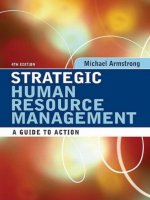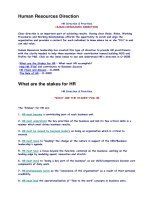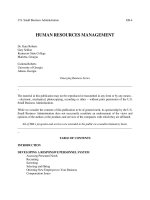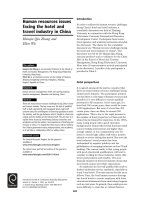Human Resources 2005
Bạn đang xem bản rút gọn của tài liệu. Xem và tải ngay bản đầy đủ của tài liệu tại đây (37.42 KB, 3 trang )
Human Resources 2005
Core Skills/Competencies Assessment Form
HR Core Skills:
Circle all areas below where you have demonstrated successful results in using the core skills listed. You may circle items in different skill levels. The skills listed below
are stratified to help determine the actual level of experience a person has so plans can be developed to gain more experience/proficiency.
Key Activity/ Core
Skill
Basic Advanced Master
1. Understanding
of Our
Business
• Basic understanding of the Business Process
• Knowledge of strategies, metrics, customers,
competitors and cross-functional
contributions
• Understands and can make assessment of
how HR Core Skills “fit” with delivery of the
CEO/Business Leaders’ agenda.
• Can analyze the status/state of the business
and see/explain areas of opportunity.
• Able to lead discussions about the business.
• Solid understanding of the business, the
key consumers and the positioning and
“state” of the competitive set.
• Called upon to make suggestions for
interventions to improve results based on
analysis of the business.
• Able to evaluate the cause and effect of
our interventions and anticipatively offer
counter measures to improve results.
• Takes the lead in partnering with BU LT
to educate/train the organization on our
strategies and interventions.
• Called upon to solve strategic business
problems and suggest interventions to
improve results.
• Make effective recommendations on
how to make changes in linking culture
with strategy to improve results.
• Capable of leading the BULT in the
analysis of results and guiding them to
clear, focused action plans.
• Used as the Master developer of those
training to lead the HR role in the
business.
2. Driving
Change and
Managing
Transfor-
mation
• Understands models and tools and can apply
them to basic situations in the business.
• Understands and can train others in the
theory of change and the change process, and
how they apply to improve operating results.
• Capable of developing success measures for
business change efforts, and on how to
evaluate progress/modify plans to achieve
results.
• Can lead discussions on how change plans
are built around PVP to ensure constancy of
purpose and continuity.
• Able to build good/effective working
relationships as the lever for change, and
understands the fundamentals of managing
conflict and differences to drive progress.
• Clear on the leadership role in change and on
techniques for coaching/developing leaders.
• Can lead the change process and select the
models and tools appropriate to achieve
successful results in the business.
• Sought out by BULT and others as a
resource and developer of others in change
management.
• Creates comprehensive change efforts with
clear measures and can rapidly develop
counter measures/plans as issues arise
requiring course correction.
• Models the behaviors of PVP in
interactions and in leading the process.
• Recognized as a builder of solid
relationships with leaders and those
impacted by change to ensure successful
outcomes.
• Has successfully developed of leaders for
change efforts.
• Sought out as the “sage”/advisor on
complex change processes. Has deep
command of all change models/tools
and successful experiences from using
them.
• Key resource and advisor to top
managers in the company. May also
be recognized outside of P&G.
• “Change Master” status has led to
being the resource/developer of leaders
and in leading the development of
aspiring change agents.
• Has led change successfully at almost
every level in the organization and in
most every type of organization.
3. Ability to
Create and
Manage
Culture
• Understands the concepts of culture and
strategy as two critical components for
successful business improvement.
• Has worked on projects to assess and define
culture and practiced the mechanics of
designing a culture to “fit”/support delivery
of business strategies.
• Has worked to define the sub-system/sub-
processes of the culture which drive change
with some success (rewards,
communications, leadership development,
linking customers, performance
management, etc.) and can do the gap
analysis and make recommendations for
cultural development.
• Can define the cultural linkages/levers which
support business improvement and define the
steps for making change.
• Called on to lead the design and change of
culture in support of business
improvements.
• Capable “troubleshooter” to identify the
“fixes” needed to realign/mobilize the
change effort if it stalls.
• Experienced in line and staff designs to
improve alignment and operating results.
• Experienced in the complexity of cross-
functional/cross-unit/global design issues
and has had success in these designs.
• Capable of coaching and developing
leadership competence.
• The master of cultural design and
development sought out by business
leaders to assist in the most complex
change efforts.
• The master sought out by practitioners
to coach/resource them on their efforts.
• Mentor of people who are learning the
concepts and technology – master
teacher.
• Veteran of many complex change
efforts – often recognized outside of
P&G.
4. Management
of HR
Practices/
Deliver HR
• Capable of providing organizational support
in most all of the core HR technologies. Has
achieved more advanced skills in at least one
technology.
• Participates, with more experienced
practitioners in analyzing the gaps/outages in
delivery to individuals and organizations,
and in improving the delivery.
• Able to contribute/participate in the
development of others and their
understanding of HR core technologies.
• Experienced in all the core HR
technologies and has achieved Mastery
level in at least one area.
• Serves as the leader in delivery of HR core
technologies to an organization, and
manages others in the delivery of services.
• Advanced problem solving/issue
resolution skills ensuring speed of
delivery. Also experienced enough to
have created new and innovative
approaches to the delivery of technologies,
or in creating new technologies.
• Expert trainer/coach developer of others.
• Mastery level in at least three of the
HR core technologies. Resource to the
practitioners and the organization at
large.
• Creator of new and better programs
and delivery systems.
• Master used by leaders of the
organization as coach/confidant and
problem solver when needed.
• Perpetrator of excellence in the
system.. The master teacher and
developer of practitioners and leaders.
5. Personal
Credibility
and Influence
• Has moved into the role as a result of
establishing a record of trust and credibility
in working interactions with customers and
peers.
• Learning rapidly the skill of leadership
through position and performance. Able to
impact the outcome of issues favorably
within his/her sphere of influence.
• Clearly a person whose performance
embodies the PVPs. Seen by others as one
who embodies this, even in the most difficult
pressure situations.
• Willing to stand up on issues even if it’s
unpopular. Takes risks.
• Able to work well with cross functional
peers/organizations to resolve difficult
issues effectively.
• Sought out by others to provide coaching,
perspective and support in dealing with
business, cultural or change issues.
• Admired and respected as a trusted and
credible person who can influence issues
and people to achieve good results.
• Able to lead through influence based on
his/her role and demeanor.
• Willing to take unpopular stand on
political or high pressure/unpopular issues.
Risk taker.
• The person business leaders,
organizational peers, and others seek
out for coaching and support. Highly
trusted and credible “weather vane” for
the organization.
• Viewed by most people as a role model
and living example of operating by
PVP.
• Carries great influence with leadership
and the business organization. The
person leaders seek out before taking
actions.
• Disturber of the peace/status quo.
Overall Skill/Competency Level Assessment – To develop an overall rating/assessment, review each of the areas and determine at what practical level the level of
competency lies. To be a
Mastery Level practitioner a person normally has longer service, deep experience, and a reputation for being sought out by others for
support/resourcing. Additionally, the Mastery level individual is usually classed as Mastery level in at least three of the five competencies.
To be practicing at the
Advanced Level, a practitioner is often sought out for resourcing and support, is generally deeply experienced in most all the Core technologies
listed, and is generally classed as a master in at least two of the five competencies.
The person operating at the
Basic Level is newer in the practice, experienced in many of the core technologies, is rapidly learning and contributing, and normally has
advanced level skills and proficiency in at least one technology area.
Overall (check one): q Basic
q Advanced
q Master
Please add any comments important for amplifying this assessment. Be sure to use this assessment and work plans to develop the person’s W&DP/Work Plan for the period
ahead.
skill assess/cab









